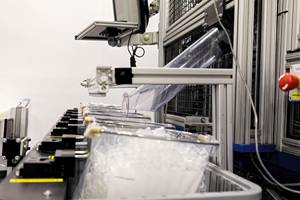Colored PET: Pretty To Look At; Headache For Recyclers
Plastics Recyclers of Europe believes that 'colorful’ future trends will weaken the image of PET as a recycled product.

oPTI lightweight foamed PET bottles from Plastic Technologies Inc (PTI). The company says the process enables white or silvery colored bottles to be made without additives.
PET. Thanks to its hygienic, strong and extremely lightweight characteristics, the packaging industry has embraced the material. And don’t forget that PET is the largest material recycled in both the U.S. and Europe. Traditionally, unpigmented PET has the highest value and the widest variety of end-use applications for recycling, according to the Association of Postconsumer Plastic Recyclers (APR, Washington, DC, USA).
But trends aren’t always about what’s easy and right now, many brands are taking a new path: colored packaging. The idea behind packaging with bright colors is pretty simple: it produces bottles with striking visual attributes and offers the potential to give brands differentiation in the marketplace. But this ‘colorful’ world of packaging could be problematic for recycling.
The trade group Plastics Recyclers Europe (PRE, Brussels, Belgium) recently discussed how the markets of milk packaging, home and personal care are switching from HDPE to PET for cost, marketing and sustainability reasons. However, this market shift could bring about more than 300,000 additional tones of colored PET, including black and white colors. PRE warns that the PET recycling markets can’t afford to absorb these extra colors.
“If collected and sorted together, these numerous colored containers will need extra sorting in the PET recycling plants,” the organization stated. “In order for recyclers to sell this colored fraction, the material will have to be tinted in black or grey, but no market currently exists for such a material in high quantities.”
According to the APR, the use of translucent and opaque colors is for bottle-to-bottle and engineered resin uses. Although newer sorting technology is capable of identifying white PET from other PET colors, much is also problematic and should be examined for their impact on the recycling process. Inclusion of nucleating agents, hazing agents, fluorescers and other additives for visual and technical effects should be examined specifically by the reclaiming industry for impact on the overall plastic bottle recycling stream, the APR states.
PRE says that its data shows that if PET milk bottles contain TiO2, the recyclers’ end product will be highly contaminated. For example, the transparency of clear recycled PET will be reduced (i.e. haze affect), while colored recycled PET will have TiO2 up to 5%. In both cases, this will lead to a fall in the use of recycled PET on the market, the group states.
“These ‘colorful’ future trends will weaken the image of PET as a recycled product. Additionally, it will create great difficulties for the PET recycling industry, which already has other market barriers to overcome,” the group said. “Furthermore, the existing HDPE recycling industry, which already has a market for colored HDPE applications (e.g. the pipe industry) will suffer if colored PET continues to grow.”
The solution? PRE believes its full body sleeves/labels that could still produce a colorful effect. But let’s not forget that full body shrink sleeve labels also present plenty of problems in the recycling process. PRE says it calls on the PET and HDPE value chains to join efforts to avoid breaking the circular functioning of these recycling streams.
What are your thoughts about this? Should PET have a colorful future?
Related Content
How Was K 2022 for Blow Molding?
Over a dozen companies emphasized sustainability with use of foam and recycle, lightweighting and energy savings, along with new capabilities in controls, automation and quick changeovers.
Read MoreProcessing Megatrends Drive New Product Developments at NPE2024
It’s all about sustainability and the circular economy, and it will be on display in Orlando across all the major processes. But there will be plenty to see in automation, AI and machine learning as well.
Read MoreAs Currier Grows in Medical Consumables, Blow Molding Is Its ‘Foot in the Door’
Currier Plastics has added substantial capacity recently in both injection and blow molding for medical/pharmaceutical products, including several machines to occupy a new, large clean room.
Read More50 Years...600 Issues...and Still Counting
Matt Naitove marks his first half-century in plastics reporting, with a few of his favorite headlines.
Read MoreRead Next
Recycling Partners Collaborate to Eliminate Production Scrap Waste at NPE2024
A collaboration between show organizer PLASTICS, recycler CPR and size reduction experts WEIMA and Conair will seek to recover and recycle 100% of the parts produced at the show.
Read MoreMaking the Circular Economy a Reality
Driven by brand owner demands and new worldwide legislation, the entire supply chain is working toward the shift to circularity, with some evidence the circular economy has already begun.
Read MoreBeyond Prototypes: 8 Ways the Plastics Industry Is Using 3D Printing
Plastics processors are finding applications for 3D printing around the plant and across the supply chain. Here are 8 examples to look for at NPE2024.
Read More












 (2).jpg;maxWidth=300;quality=90)













